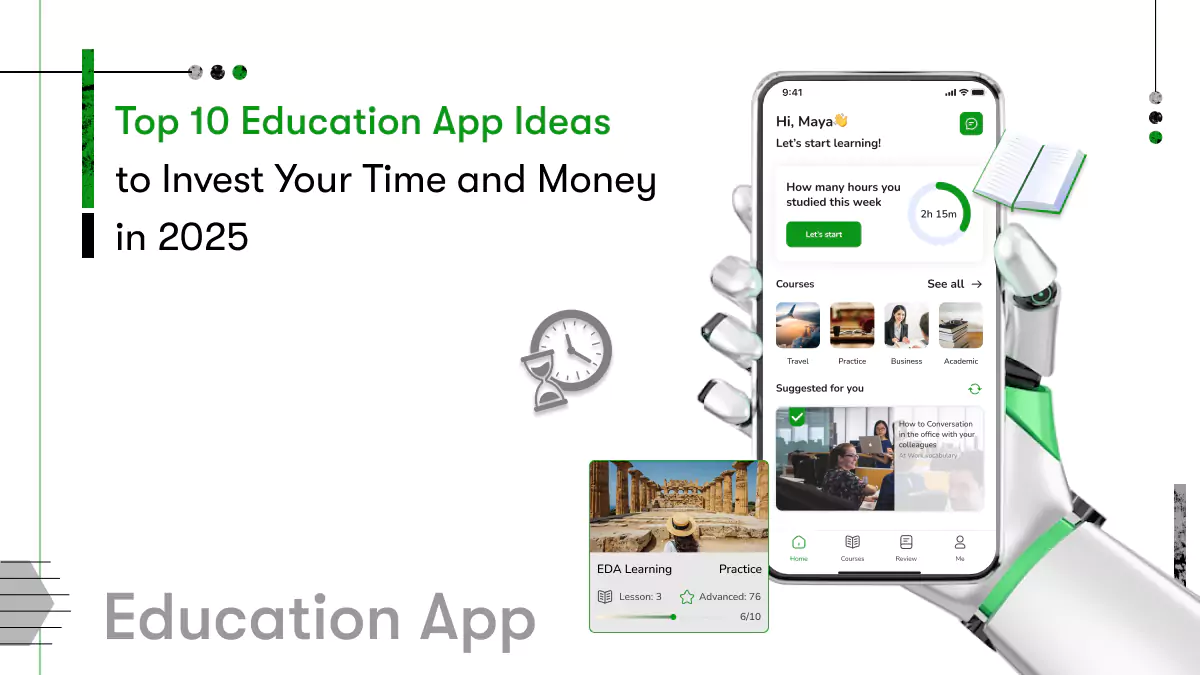Imagine a world where a struggling student doesn’t merely flip through dull textbooks but goes on a virtual journey through history, chatting with AI versions of Einstein and Cleopatra. Imagine a classroom where equations and theorems don’t merely appear on paper but spring to life in augmented reality, making quantum physics as exciting as a science fiction adventure.
Education is no longer confined to four walls or dictated by rigid curriculums. It is evolving, reshaped by technology, redefined by innovation. Education app ideas are the architects of this transformation, bridging gaps, breaking barriers, and making knowledge more accessible than ever.
Whether it’s an app that teaches coding through immersive storytelling or one that helps students ace exams by adapting to their unique learning styles, the digital revolution in education is unfolding before our eyes.
In 2025, the question isn’t whether educational apps will revolutionize how we learn, but how they will continue to stretch the boundaries of what is possible.
Whether you’re an investor, an entrepreneur, or an educator eager to catch the wave of online learning, you’re in the right place. Here’s a carefully selected list of the top 10 education app ideas for 2025; each a gateway to the future of learning.
Did you know? By 2026, the global e-learning market is forecast to reach almost 400 billion U.S. dollar. (Statista)
What are the Top 10 Education App Ideas to Invest Your Resources in?

With education technology (EdTech) experiencing tremendous growth, there has never been a better time to explore education app ideas to invest your time and money in.
Here lies the challenge though, how do you figure which education app ideas are worth your investment?
With countless apps flooding the market, standing out requires innovation, usability, and real-world impact. So, how do you decide which app idea for education will get you your money’s worth?
Well, we bring you a carefully curated list of top education app ideas that hold strong market potential in 2025.
1. AI-Powered Personalized Learning Apps
All students do not have the same rate of learning. Conventional classrooms adopt a one-size-fits-all model where some students get left behind while others get too advanced. AI-driven learning mobile app development fills that gap.
With the use of machine learning algorithms, these apps identify a learner’s strengths, weaknesses, and learning patterns to develop personalized lesson plans. These apps provide adaptive quizzes, immediate feedback, and gamified tasks to keep students interested.
A real-world example of AI-powered personalized learning is Duolingo. Duolingo uses AI to personalize language learning. The app adjusts the difficulty of exercises based on the user’s progress and learning patterns, making it one of the most effective tools for mastering a new language.
Key Features to include:
- AI-driven learning paths
- Interactive quizzes and progress tracking
- Voice and handwriting recognition for engagement
- Integration with AR/VR for immersive learning
2. AR & VR Based Learning Apps
Wouldn’t it be great if students could carry out virtual science experiments, study ancient civilizations, or rehearse surgical operations without having to step out of their houses?
Augmented Reality (AR) and Virtual Reality (VR) are changing the education sector by rendering learning more immersive and experiential. Such apps are most beneficial for medical students, engineers, and history buffs who require realistic simulations.
A real-world example of AR & VR based learning app is Google Expeditions. Google Expeditions permitted students to make virtual trips to space, underwater, and historic places before its discontinuation. Nevertheless, more recent applications such as VictoryXR and Unimersiv are still at the forefront of VR-based learning.
Key Features to include:
- 360° virtual tours for history, science, and geography
- AR-based object recognition for interactive learning
- Haptic feedback for hands-on virtual experiments
- AI tutors to guide students through virtual lessons
3. AI-powered Chatbot Tutors
Imagine if students had a 24/7 tutor at their fingertips who could respond to their queries in an instant. AI-powered chatbot tutors make this a reality. These bots can describe things, solve equations, and even provide step-by-step instructions.
With the emergence of Generative AI (imagine ChatGPT and Google Gemini), the need for intelligent tutoring assistants is exploding.
A real-world example of this is Socratic by Google. Socratic by Google helps students with homework by providing step-by-step solutions, explanations, and additional resources. The app uses AI and image recognition to scan questions and offer tailored responses.
Key Features to include:
- AI-driven Q&A system
- Voice and text recognition
- Integration with major learning platforms (Google Classroom, Khan Academy)
- Instant explanations for mathematical and scientific problems
4. Gamified Learning Platforms for Kids
Kids love games. What if learning could be like playing Minecraft or Roblox? Education gamification enhances engagement, retention, and motivation. Such apps make learning a challenge, quiz, or competition to entertain.
A real-world example of a gamified learning platform would be Kahoot! Kahoot! Allows teachers to create quizzes and integrate interactive games into the course that make learning more engaging and fun for students.
Key Features to include:
- Leaderboards and achievement badges
- Multiplayer modes for peer learning
- AI-based difficulty adjustments
- Parent and teacher dashboards for tracking progress
5. Coding and STEM Education Apps
The need for coding talent is higher than ever, and parents understand the value of STEM education for their kids.
An app that introduces coding, robotics, and engineering principles through hands-on lessons and projects can engage students, parents, and schools.
A real-world example of Coding and STEM education app is Sololearn. Sololearn is a web-based learning platform that provides interactive coding classes for both beginner and advanced students. Learners can acquire skills through bite-sized lessons, quizzes, and coding challenges, all on a mobile app or web site. Sololearn also has a community where students can exchange knowledge, pose questions, and challenge one another with coding problems.
Key Features to include:
- Drag-and-drop coding for beginners
- AI-powered debugging assistance
- Real-world projects for hands-on learning
- VR-based lab simulations for STEM subjects

6. Language Learning Apps with Speech Recognition
Over 1.5 billion individuals are learning English a second language. Many learners of languages do not have confident pronunciation and speaking skills.
Such a gap can be filled with an app utilizing speech recognition software to correct speech and offer conversation practice generated through AI.
A real-world example of an education app that uses AI to help non-native English speakers improve their pronunciation, grammar, and vocabulary is Elsa Speak. It listens to the users speak, identifies mistakes, and provides real-time feedback and ways to improve.
Key Features to include:
- AI-driven pronunciation correction
- Real-time conversation practice with chatbots
- Integration with video conferencing for real-life practice
- Gamified rewards and challenges
7. Skill Development & Career Advancement App
The employment landscape is changing at a fast pace with the advent of automation, artificial intelligence, and shifting industry trends. Employers are now seeking employees who can learn, adapt, and remain competitive.
Upskilling not only increases job security but also provides opportunities for promotions, salary increases, and career changes.
Real-world examples of skill development apps are Udemy and Coursera. These apps provide hundreds of thousands of courses in design, business, personal development, and more. Such platforms are great for self-paced learning with lifetime access to purchased courses.
Key Features to include:
- AI-driven course recommendations
- Certification programs with industry recognition
- Job placement assistance and mentorship
- Peer collaboration and networking features
8. AI-powered Homework Assistance Apps
AI Development powers homework apps with advanced machine learning (ML) algorithms and natural language processing (NLP) to understand student queries and provide accurate solutions.
Such apps are capable of scanning and solving problems, providing instant answers, offering personalized learning, and enabling interactive learning. Additionally, some AI-powered tools, like an AI presentation maker, can assist students in creating visually engaging presentations based on their study materials.
A real-world example of AI-powered homework assistance app would be Photomath. Photomath lets students scan math problems and get instant step-by-step solutions.
Key Features to include:
- AI-driven problem-solving
- Detailed, step-by-step explanations
- Support for multiple subjects (Math, Science, History)
- Voice and handwriting recognition
9. Collaborative Learning & Study Group Apps
Study group and collaborative learning apps are revolutionizing education by making learning more interactive, accessible, and efficient. As a student or a working professional, using these tools can assist you in retaining information better, staying motivated, and having fun while learning.
Microsoft Teams and Google Classroom are excellent examples of collaborative learning and study group apps. These tools offer video conferencing, assignment tracking, and document sharing to facilitate learning and communication.
Key Features to include:
- Real-time collaboration tools
- AI-powered flashcards and quizzes
- Group study rooms with video chat
- Task and deadline management
10. Special Education Apps for Students with Disabilities
Special education apps are demolishing barriers, building independence, and developing individualized learning opportunities that meet one’s needs. These applications are not merely computerized worksheets; they’re portals to empowerment and development.
Special education apps are invaluable resources that have the capability of unleashing students with disabilities to their full potential. Through adoption of technology such as AI and ML, you can provide an inclusive and balanced learning platform for everyone.
ClaroSpeak is a great example of a special education app for students with disabilities. It is a text-to-speech app designed to assist individuals who have reading and writing difficulties such as dyslexia. It enables users to enter or import text, which is then read out by the app in natural-sounding voices. ClaroSpeak also features word prediction, spell checking, and adjustable fonts and colors to enhance readability. It’s widely used as an assistive tool for students and working professionals who require assistance with literacy.
Key Features to include:
- AI-powered text-to-speech and speech-to-text
- Adaptive learning modules
- Voice commands for accessibility
- Real-time progress tracking for teachers and parents
The future of learning is yours to create. As technology is transforming the way we learn, it’s the best time to turn education app ideas into reality. Be it developing an AI-based tutor, an interactive language learning application, or a gamified study app, the opportunities are limitless.
Investing in education app ideas isn’t all about making money, it’s about changing the way people learn, develop, and thrive. The top education app ideas today will shape the classrooms of the future.
However, deciding on an education app idea is not enough as not every concept translates into a successful app. So, how do you choose the right app idea for education that will stand out from your competitors?
Let’s look at these criteria for selecting education app ideas in 2025.
What are the Criteria for Selecting Top Education App Ideas?

As digital learning becomes increasingly mainstream, the need for innovative education app ideas increases by the day. As an entrepreneur, educator, or developer, selecting the best app ideas for education is paramount to developing a successful and meaningful product.
However, with all the existing educational mobile apps ideas already in the market, how do you select one that stands out?
Let’s explore the essential criteria for selecting top education app ideas that can thrive in 2025 and beyond.
1. Addressing a Real Educational Need
The first and most critical criterion for selecting ideas for educational apps is recognizing an actual learning demand. Does your app address a widespread issue facing students, teachers, or parents?
The best-performing educational mobile apps ideas offer solutions to issues such as:
- Lack of access to quality education
- Personalized learning for different skill levels
- Skill-building beyond traditional classroom subjects
For instance, language learning software and tutoring apps using AI have become popular since they address an actual learning need.
2. Target Audience and Market Demand
Before you settle on your education app ideas, identify who your target users are. Are you developing for school pupils, college students, professionals, or lifelong learners? Thorough market research will assist you in knowing demand and competition.
Some top education app ideas cater to:
- School students (K-12) needing interactive learning tools
- University students requiring exam preparation support
- Professionals seeking skill development and certifications
Understanding your audience helps you tailor features, content, and the user experience to meet their needs effectively.
3. Innovation and Uniqueness
Since there are already thousands of educational mobile app ideas, innovation is the key to differentiating. Your app must present a distinctive way, either in gamification, AI-driven evaluations, or learning pathways.
For example, education app ideas 2025 might include:
- Augmented Reality (AR) for interactive learning experiences
- AI-driven personalized tutoring assistants
- Blockchain-based credential verification systems
New features not only will bring in users but also enhance engagement and retention.
4. Ease of Use and Accessibility
An ideal education app should have a user-friendly interface accessible to users across ages. An overly complicated interface can deter people from using the app. Other features like text-to-speech, subtitles, and offline modes can make your app more appealing to a larger user base that has disabilities or has limited access to the internet.
5. Scalability and Monetization Potential
Whereas education passion matters, a viable business model determines long-term viability. Before creating your app, consider the following:
- How it will make money (subscription model, freemium, ads, or one-time purchase)
- Whether it can be scaled to support additional users and new features in the future
- If school partnerships, college collaborations, or ed-tech firms can increase growth
Having a scalable and monetizable approach means that your education app ideas will be able to support themselves financially while continuing to deliver value to users.
Selecting the best education app ideas involves thoughtful consideration of market demand, innovation, user experience, and long-term viability. The most effective app ideas for education are those that solve actual learning problems while incorporating contemporary technology to improve engagement and effectiveness.
When brainstorming educational app ideas, concentrate on solving actual problems, utilizing technology, and developing a user-friendly experience.
Why Choose Kody Technolab Ltd for Your AI-Powered Education App?
Being a top-notch software development company, Kody Technolab is an expert in developing innovative app ideas for education, providing end-to-end solutions for learning applications powered by AI. They provide customized education app development for every educational requirement, be it K-12 learning apps with gamification, higher education platforms with AI-driven study aids, or corporate training applications for skill upgradation.
To differentiate your app from its competitors, Kody incorporates innovative features such as speech recognition for language learning, AR/VR technology for interactive learning, blockchain-based certification verification, and gamification for motivation.
As education app ideas 2025 become popular, scalability and security are paramount. Kody Technolab develops solid, cloud-based solutions with good security measures and a future-proof architecture to provide seamless updates and long-term stability.












 Contact Information
Contact Information